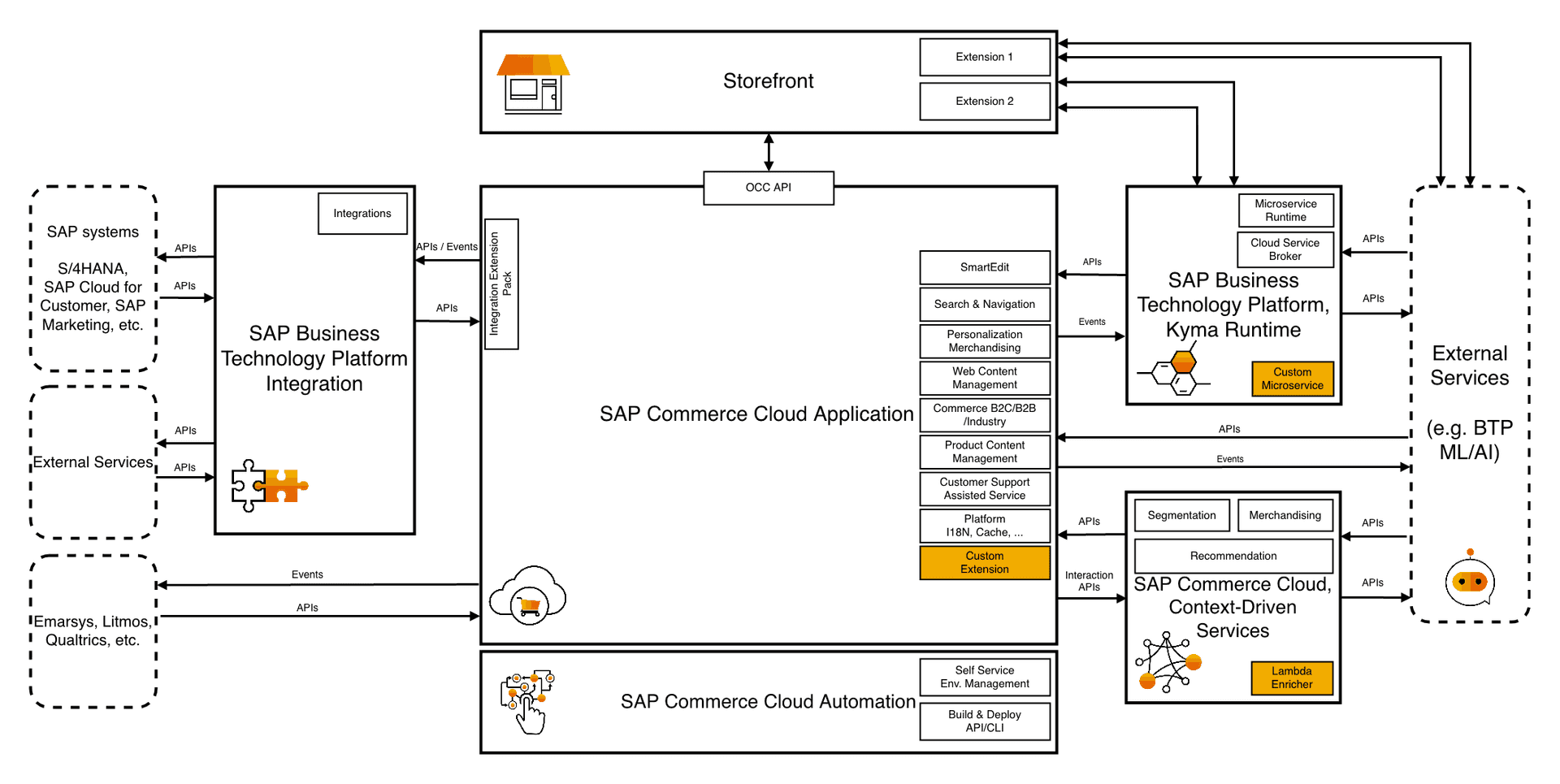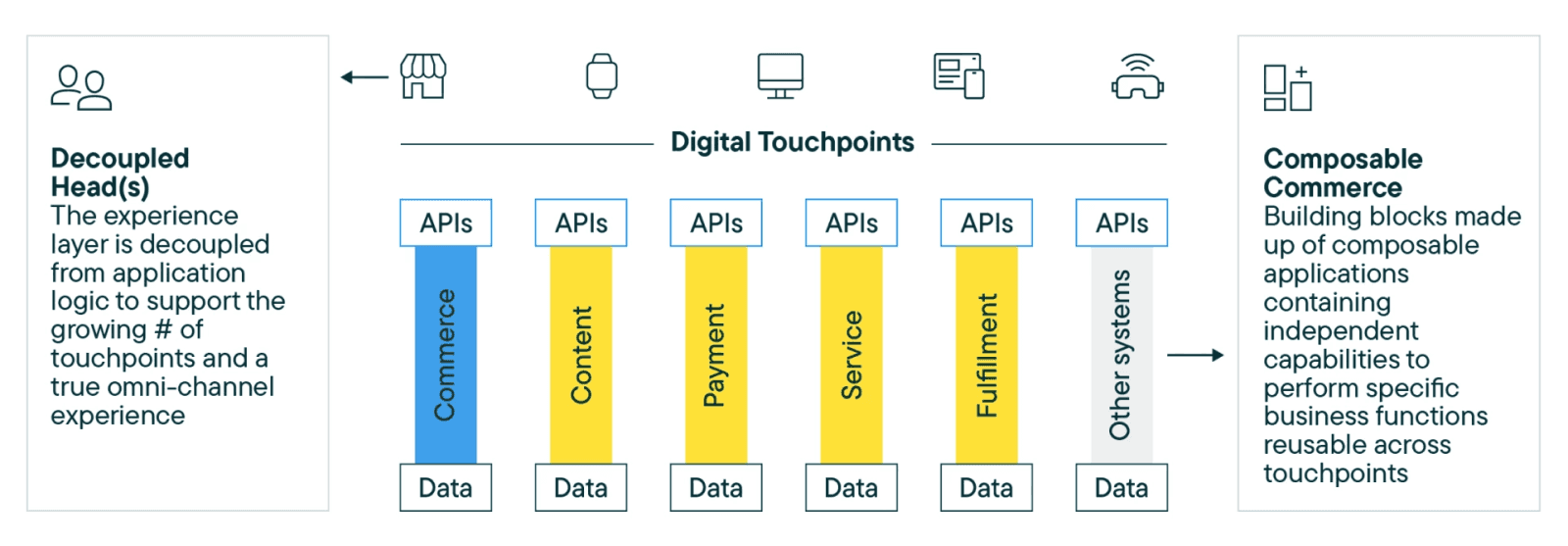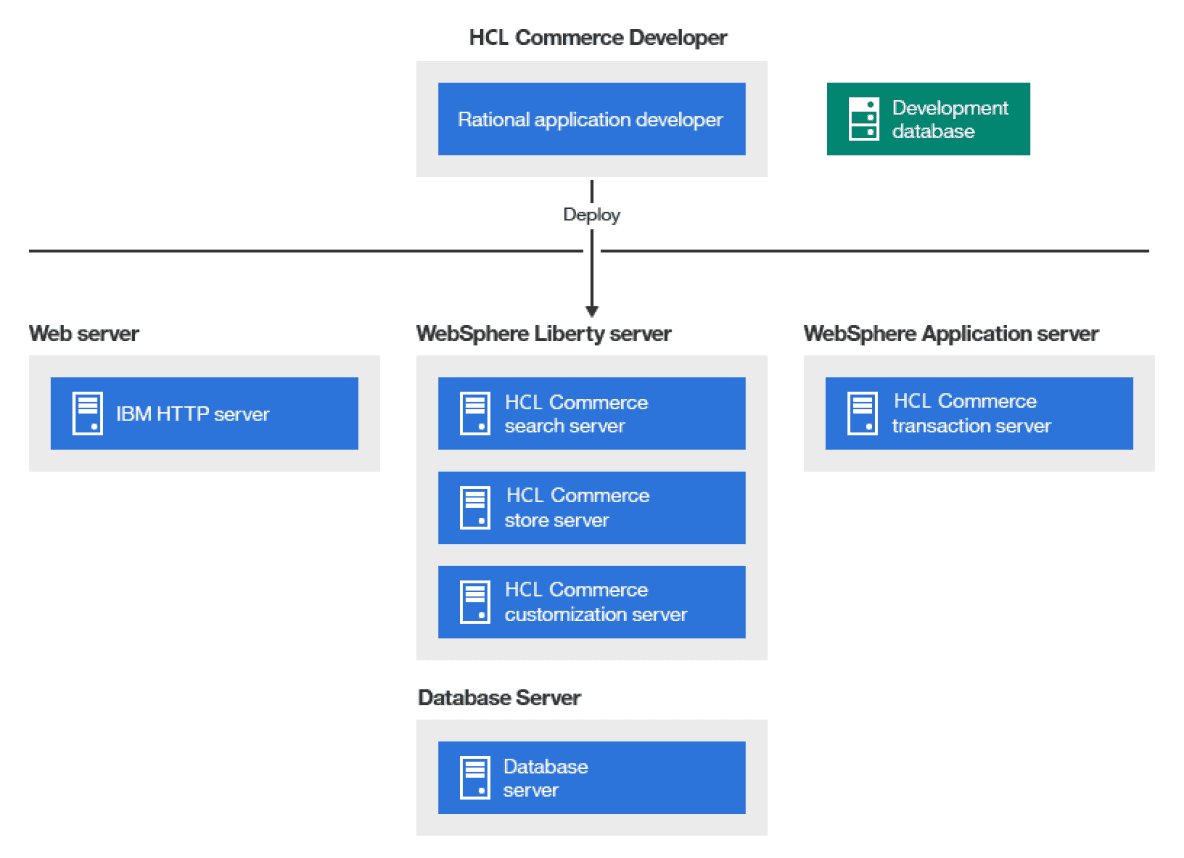
Ecommerce SaaS: key features, leading platforms, and benefits

by Gennady Atroshko,
Head of Ecommerce Solutions Department
SaaS ecommerce is a software delivery model where a SaaS provider licenses their cloud-based ecommerce platform to businesses for a monthly subscription fee. Merchants can set up online stores using out-of-the-box features and templates, while the SaaS provider handles backend operations.
According to Statista, there are 263 million digital buyers in the US, which is almost 80% of the population. To meet this growing consumer demand without spending exorbitant amounts of time and money, retailers are switching from conventional ecommerce solutions to software-as-a-service platforms, or SaaS, that provide the much-needed ease-of-adoption, flexibility, and cost-efficiency. We explore key characteristics of ecommerce SaaS solutions compared to open-source platforms, review top SaaS ecommerce platforms, and discuss the benefits and challenges of SaaS ecommerce adoption.
Chart title: Global ecommerce SaaS market size, 2028
Data source: businessresearchinsights.com — E-commerce SaaS market report, 2023
How does SaaS ecommerce work?
Hosted in the cloud, SaaS ecommerce platforms don’t require downloading and installation on a computer and can be accessed via an internet browser. In addition to providing ready-made web store solutions, ecommerce SaaS vendors cover their hosting, security provision, backups, and updates. Business owners sign up for a platform, select a store template, add necessary functionality, and proceed to create product catalogs and sell online. Ecommerce SaaS companies charge regular fees for using their software and offer different subscription plans to accommodate businesses of various sizes.
1
Sign up
- Choose the perfect Saas platform
2
Take charge of the Saas ecosystem
- Secured payment gateway SSL checkout 3rd party application
- Hosting Upgrates Maintenance
3
Go live in less than 2 weeks
- Choose your design layout Upload products
Scheme title: SaaS ecommerce setup
Data source: ecommerce-platforms.com—The state of open source ecommerce platforms
SaaS vs. open-source ecommerce: key differences
A popular alternative to SaaS solutions is open-source ecommerce software. Although it can be hard to distinguish the two just by comparing online stores built on them, these platforms’ functionalities, store setup and management requirements, and customization options are fundamentally different. You can always turn to ecommerce software experts to help you choose which model suits your business needs the best.
SaaS
Open source
User role
User role
SaaS ecommerce platforms are owned by software providers who develop a SaaS platform and run it on their servers. SaaS ecommerce platforms come as ready-to-use solutions with a few customization options and no access to the source code. Users only rent the software without the ability to change it fundamentally.
Open-source ecommerce platforms provide users access to source code, which they can download and modify, customizing the solution for their specific business needs. Thus, users take full responsibility for using the code to create and maintain online stores.
Cost
Cost
Ecommerce SaaS users subscribe to a monthly or yearly plan and pay fixed fees for using the platform. The fees also cover hosting, security, and software updates, so merchants don’t need to invest in their stores’ maintenance. Moreover, this payment model usually provides several subscription tiers so that companies can downgrade or upgrade to other plans in line with their current business needs.
Open-source platforms are generally free to download and use. However, store owners have to pay for web hosting, security and compliance provision, customization, integration with third-party apps, and store maintenance. In addition to the initial investment and regular maintenance expenses, merchants should update and modify the store and hire in-house specialists or a third-party team.
Security
Security
Ecommerce SaaS providers take necessary measures to ensure stores’ security and PCI compliance. They regularly release updates and automatically install new security features to protect ecommerce sites and customers’ payment data.
Companies opting for an open-source ecommerce platform are ultimately responsible for meeting PCI requirements, ensuring data protection, monitoring site security, and providing updates and bug fixes as needed.
Installation
Installation
Even merchants with no software development specialists can easily create stores by selecting pre-designed themes, modules, and add-ons in a beginner-friendly website builder. In addition, SaaS platforms usually have a free trial to let users explore the platform before subscribing to a paid plan.
Setting up a store based on an open-source platform requires sufficient coding knowledge.
Customization
Customization
SaaS platforms offer limited customizability compared to open source, but many vendors provide pre-built features and easily-customizable templates. Many vendors also have marketplaces providing a curated selection of extensions and APIs for third-party developers.
Open-source platforms provide unlimited customization options for storefront design, product pages, and checkout. However, businesses should hire certified developers to handle these complex changes.
Maintenance and support
Maintenance and support
Merchants running a SaaS-based store rely on the provider to perform maintenance operations, fix performance issues, and update the software. As part of the service package, SaaS users can directly contact support specialists through help desks.
Retailers have to take care of their open-source store’s maintenance, support, and updates. If an issue occurs with the system, they should find out how to resolve it and make fixes on their own or turn to third-party developers. Open-source ecommerce vendors can provide technical support only for an additional fee.
Best for
Best for
Ecommerce SaaS is popular among startups and SMEs that don’t have a mature IT infrastructure but are on a limited budget and need to handle increasing traffic. However, SaaS is also a good option for large companies focusing their efforts on business development rather than on the site’s infrastructure, maintenance, and security.
Open-source software is in demand among enterprises with in-house IT teams. Open-source platforms are also a good choice for companies that need full control of their platforms’ design and functionality and have enough budget to set up and maintain an open-source infrastructure.
Industry experts say
Open-source and on-premise solutions force businesses to build their own platform from a coding level and implement software updates themselves, respectively. Both scenarios take time that businesses cannot afford to waste.

Gregg D. Copeland
Information technology engineer at Linktech
Power your online business with an ecommerce SaaS solution
Top 7 ecommerce SaaS platforms
According to the Gartner Magic Quadrant for Digital Commerce 2022, these seven ecommerce SaaS platforms keep up with today’s industry standards and demonstrate a clear vision of future development.
Scheme title: Magic Quadrant for Digital Commerce
Data source: Gartner, 2022
Previously known as Magento Commerce, it’s a flexible and easily scalable cloud-based platform-as-a-service (PaaS) solution. The PaaS model slightly differs from SaaS, providing a ready-to-use platform for developing and running ecommerce stores in the cloud. Adobe also offers a free open-source ecommerce solution Magento Open Source.
Key features
- Multi-brand management from a single platform
Integrated payment and fraud protection
Cross-channel shopping enablement
Advanced search capabilities
Embedded Adobe Sensei AI-powered dynamic content, tiered pricing, and personalized recommendations
Real-time inventory management with sourcing and stock tracking across the distribution network
SEO and marketing tools - Over 3,600 native extensions in Adobe Commerce Marketplace for payment, tax, and shipping management
Integration with retailers’ in-house CMS, ERP, CRM, and marketing automation systems
Business intelligence features for real-time ecommerce metric analysis
150 language packs and regional extensions
Compatible with other products from the Adobe bundle
99.99% operational uptime
Best for
Medium and large B2B, B2C, and hybrid commerce enterprises
Product differentiator
Amazon sales channel with access to Sell On Amazon features
Efficiency, versatility, and ease of use
Limitations
A steep learning curve
API customization requires vendor-sponsored developers
Some B2B functionality is missing
Pricing
Customized pricing on demand
Used by
Powers more than 315,000 sites globally, including HP, Helly Hansen, FoodServiceDirect.com, Liebherr, Rossignol
A highly-scalable cloud-based, headless ecommerce platform with powerful content management, personalization, and merchandising capabilities
Key features
- B2C Commerce targeted at end consumers across different verticals
B2B Commerce aimed at business buyers, such as dealers and distributors
Multiple storefront support
Einstein AI engine for ecommerce predictive analytics and hyper-personalized shopping experiences
Omnichannel commerce capabilities
A suite of related Salesforce products complementing the ecommerce functionality - Easy process management with a simple drag-and-drop user interface
Merchandising and product display optimization tools for cross-selling, upselling, and product recommendations
Mobile enablement of every customer touchpoint
Self-service options
Multilingual support and connection to an external translation system
24/7 customer support
Best for
Medium B2C and B2B enterprises and large-scale retailers
Product differentiator
Automatic domain capacity adjustment to handle traffic spikes
Easy integration with other Salesforce applications
Limitations
- Can be expensive for small businesses
- A steep learning curve
- Can require programming expertise and help from Salesforce consultants
Pricing
Pricing is based on the number of orders per month
Various pricing options for different business models
Available upon request
Used by
Puma
American Red Cross
Lacoste
Burton
Previously known as SAP Hybris, SAP Commerce Cloud is a cloud-native, enterprise-level platform that brings highly complex ecommerce scenarios to life.
Image title: SAP Commerce Cloud architecture
Data source: SAP, 2022

Key features
- Pre-built features and components for various kinds of ecommerce stores and marketplaces
Context-driven services, including Merchandising for product recommendations and Customer Recovery for shopping cart abandonment campaign creation
Out-of-the-box accelerator frameworks to minimize costs and time-to-market
Comprehensive omnichannel features for frictionless customer experience across channels - Numerous easy-to-implement integrations built by SAP Commerce community developers
An extensive knowledge base on platform use
Support of multiple languages, currencies, and payment processing methods
Real-time insights into customer behavior and preferences for personalized online shopping experiences and more precise targeting
Best for
Medium and large B2B, B2C, and B2B2C enterprises
Product differentiator
A single solution for centralized management
Platform modularity with the capability of modifying or replacing every service that resides on ServiceLayer API
Seamless integration with all SAP products
Limitations
Requires more development efforts than alternative platforms
Can be expensive to implement and maintain
Platform complexity
Pricing
Subscription-based pricing plan. The fee depends on the number of components, integrations, and service storage the customer uses
Available upon request
Used by
7 Eleven
Chanel
Whirlpool Corporation
Boeing
Trek Bicycle Corporation
A cloud-based ecommerce platform with a low entry barrier.
Key features
- Easy frameworks for mobile adoption
A large number of payment gateways for online payment processing, including PayPal and Amazon Pay
Elaborate features for selling internationally
Built-in SEO and marketing tools
All Shopify customers are guaranteed unlimited storage and bandwidth regardless of the pricing plan - Tools for automatic generation of business and domain names and creation of logos and business cards
Thousands of free and paid applications for storefront customization
50 languages and translation support
Best for
Businesses of all sizes, predominantly for B2C sales
Retail companies or entrepreneurs with a limited budget
Merchants for which fast time to market is preferable
Midsize and large enterprises can consider using Shopify Plus
Product differentiator
User-friendly software that doesn’t require in-depth technical knowledge
Simple selling requirements
Limitations
Setting up multiple stores can involve additional costs
Limited official training resources
Limited capability for sophisticated customization
B2B support available only on the Shopify Plus plan
Pricing
A free 3-day trial + $1 per month for 3 months on select plans
Various payment plans with different levels of complexity starting from $24 per month
Used by
Penguin Books, Sephora, Jigsaw, Hasbro, Pure Electric, BBC, Heinz, Red Bull, Lindt
An all-in-one open SaaS ecommerce solution with a comprehensive commerce feature set.
Key features
- A drag-and-drop visual editor for building pages
Customizable checkout
Responsive design
Out-of-the-box SEO tools
Cross-channel commerce capabilities with native POS systems, multi-storefront dashboard, and social media and marketplace integrations, e.g., with Instagram and eBay - B2B functionality for customer segmentation, bulk pricing, quote management, and purchase order management
Reports and analytics for orders, customer data, marketing
Seamless integration of third-party systems through fast APIs
24/7 customer support
99.99% uptime
Best for
Small and midsize B2B, B2C, and D2C organizations
Product differentiator
Easy to setup and use with no coding experience
Limitations
Transaction fees in all plans
Complicated customization
Some common functionality requires partner integrations
Pricing
Four plans: Standard, Plus, Pro, and Enterprise
starting from $29 per month
15-day free trial
Used by
Sony, Skullcandy, Solo Stove, Casio, GE Appliances
A modular, API-first, and versionless SaaS ecommerce platform.

Image title: Commercetools’ composable commerce at a glance
Data source: commercetools.com — What is composable commerce and why does it matter? Your questions answered, 2023
Key features
- Storefront and page builder capabilities
300+ API endpoints
A decoupled storefront creator with a unique ability to preview real-time edits via a QR code across devices
An option of connecting to other headless content management systems or digital experience platform offerings
Native capabilities for omnichannel commerce - A vast knowledge base for developers and business users
Easy development due to the microservices approach and language-agnostic backend
Guaranteed 99.99% platform reliability and disaster recovery
24/7 support
Best for
Mid-size to large global B2C, B2B, D2B organizations with complex requirements and tech-savvy teams
Product differentiator
A leader in the composable commerce space with its SaaS-based MACH architectural principles
Limitations
Complex and expensive to implement
Limited B2B functionality compared to direct competitors
Pricing
A 60-day free trial
Prices upon request
Used by
Audi, Bang & Olufsen, Express, Ulta Beauty, Salling Group
HCL Commerce is a highly composable commerce solution with a rich set of out-of-the-box commerce capabilities.
Image title: Software components related to HCL Commerce
Data source: help.hcltechsw.com — HCL Commerce common architecture

Key features
- Reference storefronts available for faster time to market
A powerful search engine with natural language processing, zero results management, and visual merchandising capabilities
Out-of-the-box sophisticated global multisite capabilities
Built-in precision marketing, promotion, and personalization tools - Marketplace capabilities for one-stop-shop customer experiences
Support of up to 40,000 orders an hour during peak buying times
Built-in customer service with call center capabilities
A free onboarding advisory service
16 languages and 30+ currencies supported
Best for
Mid to large companies with complex use cases requiring scalability for high traffic and transaction volumes associated with B2B, B2C, and B2B2X business models
Product differentiator
An option to purchase a single perpetual license
Limitations
Complex admin UI
Technologically complex
Pricing
A free trial
Custom pricing, available upon request
Used by
Prada, Ford Accessories, Farmtek, Gymboree
Ecommerce SaaS benefits
Cost-effective
By opting for SaaS, companies can reduce ecommerce platform development, deployment, and maintenance costs.
Fast setup
Ecommerce SaaS platforms offer all the basic functionality for online stores. With user-friendly interfaces and pre-built themes, companies can quickly set up a store and enter the market.
Easy to maintain
Since SaaS ecommerce providers take care of software updates, bug fixes, and server maintenance, companies can do without a dedicated IT team.
PCI-compliant and secure
All major SaaS ecommerce platforms are PCI-compliant, mitigating regulatory risks for companies and ensuring that customers’ sensitive financial information is well-protected.
Easy integration
Most SaaS ecommerce platforms can be easily integrated with other business systems, such as ecommerce CRM, POS, and ecommerce ERP.
Highly scalable
SaaS ecommerce platforms allow adopters to expand storage and add new functionality and sales channels, enabling unlimited scalability.
Benefits
Common challenges of ecommerce SaaS
While SaaS solutions provide multiple payoffs and growth opportunities, this ecommerce model still has some shortcomings that merchants should be aware of.
Challenge
Solution
Limited customization opportunities
Ecommerce SaaS solutions use built-in, easily configurable templates and features that limit the customization scope.
Ecommerce SaaS solutions use built-in, easily configurable templates and features that limit the customization scope.
Ecommerce companies using SaaS software can establish a headless architecture to enable API-based app integrations and personalization of the frontend and storefront functionality. However, if retailers require extensive customization to fit their unique business needs, they should opt for an open-source ecommerce platform instead.
Lack of control
Since SaaS ecommerce platforms run on the provider’s servers, companies don’t have control over them and fix emerging problems themselves.
Since SaaS ecommerce platforms run on the provider’s servers, companies don’t have control over them and fix emerging problems themselves.
Ecommerce businesses should choose a reliable SaaS platform that provides regular software updates, performs automatic store checks for early problem detection and downtime prevention, and offers 24/7 technical support to resolve any issues.
Vendor lock-in
Switching from a SaaS solution to another ecommerce platform is associated with substantial costs and complexity, which makes businesses dependent on their initial choice.
Switching from a SaaS solution to another ecommerce platform is associated with substantial costs and complexity, which makes businesses dependent on their initial choice.
When choosing a SaaS ecommerce platform, retailers should study the provider’s offer in advance and consider their scaling potential so that their business won’t outgrow the platform’s capabilities too soon. What’s more, companies should keep backups of all the data they store in a SaaS solution to mitigate the risks of future migration.
Launch a SaaS-based store with expert help

SaaS ecommerce platforms allow for time-to-market acceleration and require significantly lower upfront costs. Although their customizability is more modest than that of open-source solutions, ecommerce SaaS platform providers are reacting to the current market demand for greater flexibility and introducing changes to overcome this restriction.
This way, SaaS ecommerce platforms are the best choice for retail companies wanting to quickly react to ever-changing market trends and meet constantly fluctuating customer needs and wants. However, if you hesitate whether SaaS commerce is a good option for your business, Itransition can help you decide which ecommerce software type and SaaS platform suits your requirements and growth plans the best.
Consumer purchasing habits, expectations, and demands evolve at a rate that is nearly as fast as eCommerce technology. We observed this personally when the epidemic altered not only what people bought, but also how they bought it. With cutting-edge capabilities like personalized search, dynamic testing, and personalized product suggestions, SaaS e-commerce allows companies to quickly respond to changing consumer needs.
.jpg)
Bram Jansen
Chief Editor of vpnAlert
Looking for a reliable SaaS ecommerce implementation partner?
Ecommerce SaaS: common questions answered
What is an example of SaaS?
Examples of popular ecommerce SaaS platforms include Adobe Commerce, Salesforce Commerce Cloud, SAP Commerce, and Shopify. One of the best-known non-commerce SaaS is Google Workspace.
How does SaaS help ecommerce?
Ecommerce SaaS allows retailers to quickly set up and easily manage ecommerce websites, attract customers, and sell products online.
How to choose the best ecommerce SaaS platform?
Different ecommerce SaaS companies provide different sets of services and features, so merchants should study their offers and consider the pros and cons of each platform to make an informed decision. Alternatively, retailers can partner with trusted ecommerce consultants to make the best choice.

Service
Ecommerce consulting services: key options, platform expertise, and benefits
Discover how retailers can improve their digital commerce strategy and significantly enhance their online store performance with ecommerce consulting services.

Service
Ecommerce CRM: features, integrations & top platforms
Explore how ecommerce CRM systems help retailers streamline customer data management, personalize buying journeys, and effectively convert leads to sales.

Case study
Digital commerce solution for IT retailer
Learn how Itransition delivered an Adobe-based ecommerce solution and optimized its performance with extensions for a Canadian IT retailer.

Insights
Accelerating ecommerce growth with predictive analytics
In this article, we discuss how ecommerce companies can implement predictive analytics to boost customer loyalty, optimize operations, and increase profits.